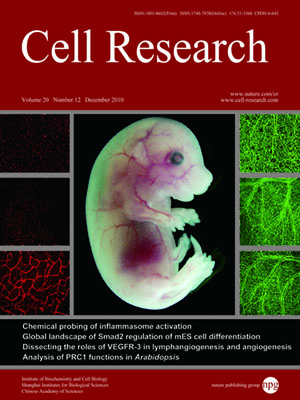
Volume 20, No 12, Dec 2010
ISSN: 1001-0602
EISSN: 1748-7838 2018
impact factor 17.848*
(Clarivate Analytics, 2019)
Volume 20 Issue 12, December 2010: 1361-1371
ORIGINAL ARTICLES
Structural basis of immunosuppression by the therapeutic antibody daclizumab
Hui Yang1,2,*, Jianchuan Wang1,2,*, Jiamu Du1,4, Chen Zhong1, Dapeng Zhang3, Huaizu Guo3, Yajun Guo3 and Jianping Ding1
1State Key Laboratory of Molecular Biology and Research Center for Structural Biology, Institute of Biochemistry and Cell Biology, Shanghai Institutes for Biological Sciences, Chinese Academy of Sciences, Shanghai 200031, China
2Graduate School of Chinese Academy of Sciences, 320 Yue-Yang Road, Shanghai 200031, China
3International Joint Cancer Institute, Second Military Medical University, 800 Xiang-Yin Road, Shanghai 200433, China
4Current address: Memorial Sloan-Kettering Cancer Center, RRL 269, 430 E 67th Street, New York, NY 10021, USA.
Correspondence: Jianping Ding,(jpding@sibs.ac.cn)
Interleukin-2 (IL)-2 signaling plays a pivotal role in the activation of immune responses, and drugs that block this pathway have been shown to be effective for the immunosuppression in patients with organ transplantation to alleviate/eliminate allograft rejection. The first humanized monoclonal antibody (mAb) daclizumab falls into this category and shows high specificity and affinity against a key component of the IL-2 receptor complex, namely IL-2R
α. To reveal the molecular mechanism of the inhibition of the IL-2 signaling pathway by daclizumab, we determined the crystal structures of the daclizumab Fab in free form and in complex with the IL-2R
α ectodomain at 2.6 and 2.8 Å resolution, respectively. The daclizumab Fab adopts a similar conformation in the presence or absence of the IL-2R
α ectodomain. The antigen-binding site of daclizumab is mainly composed of five complementarity determining regions (CDRs) that form a large positively charged surface depression and two flanking patches that are generally hydrophobic. The conformational epitope consists of several discontinuous segments of the IL-2Rα ectodomain, a large portion of which overlaps with the regions that interact with IL-2, suggesting that the binding of daclizumab to IL-2Rα would prevent the IL-2 binding to IL-2Rα and the subsequent formation of the IL-2/IL-2Rαβγ
c complex, and therefore block the IL-2 signaling pathway. These results also have implications for the design and development of improved mAb drugs targeting IL-2Rα.
Cell Research (2010) 20:1361-1371. doi:10.1038/cr.2010.130; published online 7 September 2010
FULL TEXT | PDF
Browse 2391


